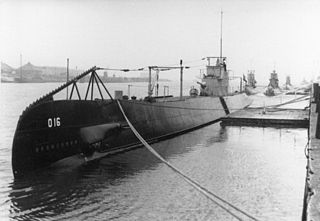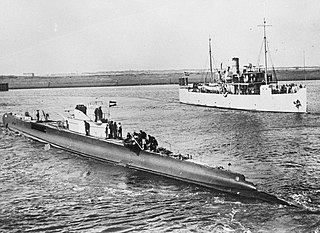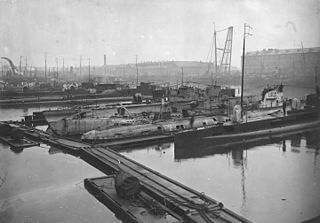
The Mariana Trench or Marianas Trench is located in the western Pacific Ocean about 200 kilometres (124 mi) east of the Mariana Islands; it is the deepest oceanic trench on Earth. It is crescent-shaped and measures about 2,550 km (1,580 mi) in length and 69 km (43 mi) in width. The maximum known depth is 10,984 ± 25 metres at the southern end of a small slot-shaped valley in its floor known as the Challenger Deep. If Mount Everest were hypothetically placed into the trench at this point, its peak would still be underwater by more than 2 kilometres (1.2 mi).

A deep-submergence vehicle (DSV) is a deep-diving crewed submersible that is self-propelled. Several navies operate vehicles that can be accurately described as DSVs. DSVs are commonly divided into two types: research DSVs, which are used for exploration and surveying, and DSRVs, which can be used for rescuing the crew of a sunken navy submarine, clandestine (espionage) missions, or both. DSRVs are equipped with docking chambers to allow personnel ingress and egress via a manhole.
The Submarine Escape Training Facility (SETF), also known as the Submarine Escape and Rescue Centre (SERC), is a facility used by submariners of the Royal Australian Navy (RAN) to train in the techniques needed to escape from a submarine in trouble.

The Jacob van Heemskerck-class frigate was a class of frigates of the Royal Netherlands Navy. They were designed to be an air defence version of the Kortenaer class. The helicopter was replaced by a Standard medium range surface-to-air missile (SAM) system and associated radars. Two ships were built for the Royal Netherlands Navy. In 2005 they were sold to the Chilean Navy.

The Dolfijn-class submarines of the Royal Netherlands Navy are a class of four submarines; Dolfijn, Zeehond, Potvis and Tonijn. They were built in the late 1950s and the early 1960s. They were the first indigenous submarines built in the Netherlands and for the Royal Netherlands Navy after World War II. In the Netherlands they are also known as "three cylinder" submarines.

The K VIII-class submarine was a three boat class of submarines of the Koninklijke Marine. The class varied from K V-class submarine due to the removal of two external torpedo tubes, which were removed to reduce the boats' vulnerability to depth charging. The boat had a diving depth of 50 metres (160 ft).
The O 9-class submarine consisted of three submarines, built for the Royal Netherlands Navy. Used for patrols in the Dutch home waters. The class comprised O 9, O 10, and O 11. Its diving depth was 60 metres (200 ft).

The O 12-class submarine consisted of four submarines built for the Royal Netherlands Navy. The ships, with a diving depth of 60 metres (200 ft), were used for patrols in the Dutch home waters. The class comprised O 12, O 13, O 14 and O 15. O 12 entered German service in 1943 as UD-2.

The O 19 class was a class of two submarines, built for the Royal Netherlands Navy by Fijenoord, Rotterdam. The ships were designed as submarine minelayer for operations in both European and colonies waters. The class comprised O 19 and O 20 and were the first submarines in the world to be equipped with a submarine snorkel that allowed the submarine to run its diesel engines while submerged. The submarines diving depth was 100 m (330 ft). These units were very similar to earlier Polish Orzeł class, with a reduced torpedo battery and 10 vertical mine tubes fitted on each beam.

The O 21 class was a class of seven submarines, built for the Royal Netherlands Navy. The boats were still incomplete at the start of the German invasion of the Netherlands O 21, O 22, O 23 and O 24 were hastily launched and escaped to the United Kingdom. O 25, O 26 and O 27 were not able to escape and were captured by the German forces. The Kriegsmarine ordered the completion of the boats and they entered German service as UD-3, UD-4 and UD-5. The submarines diving depth was 100 meters (330 ft).

HNLMS O 16 was a submarine of the Royal Netherlands Navy that saw service during World War II. She was the first submarine of the RNN manufactured from high-quality Steel 52, with the ability to dive at a depth of 80 metres (260 ft).

Kommuna is a submarine salvage ship in service with the Russian Navy's Black Sea Fleet and the world's oldest active duty naval vessel. A double-hulled catamaran, she was laid down at the Putilov Factory in St. Petersburg in November 1912 as Volkhov. The ship was launched the following year, and commissioned on 14 July 1915. She was renamed Kommuna on 31 December 1922. Kommuna has served in the Russian Imperial, Soviet, and Russian Federation navies through the Russian Revolution and two World Wars.
O 6 was a unique patrol submarine of the Royal Netherlands Navy for European home waters. The ship was built by De Schelde shipyard in Flushing. The submarines diving depth was 40 metres. O 7 was very similar to the O 6 and they are sometimes regarded as one class.
HNLMS O 7 was a unique patrol submarine of the Royal Netherlands Navy for use in the home waters of Europe. The ship was built by the Maatschappij Fijenoord shipyard in Rotterdam. The submarines diving depth was 40 metres. O 6 was very similar to the O 7 and they are sometimes regarded as one class.

O 1 was a Holland 7P patrol submarine of the Royal Netherlands Navy. The ship was built by the De Schelde shipyard in Flushing and was the first submarine in the Dutch navy. It had a diving depth of 25 metres.

The K III class was a class of two patrol submarines, built by Koninklijke Maatschappij De Schelde in Vlissingen for the Royal Netherlands Navy. Used for patrols in the Dutch colonial waters. The submarines diving depth was 40 metres (130 ft). The design for the double hulled boats came from the American Electric Boat Company.

K XVII was one of five K XIV-class submarines built for the Royal Netherlands Navy. She served during World War II.

Charles Brun was a submarine built for the French Navy during the first decade of the 20th century, the only boat of her class.

The Clorinde-class submarines were built for the French Navy prior to World War I. There were two boats in this class, neither of them would be used during World War I, but they operated in the Atlantic Ocean and the English Channel until they were stricken in 1926.















